Floor/stringer repair: how far? |
Post Reply 
|
Page <123> |
| Author | |
JoeinNY 
Grand Poobah 

Joined: October-19-2005 Location: United States Status: Offline Points: 5693 |
 Post Options Post Options
 Thanks(0) Thanks(0)
 Quote Quote  Reply Reply
 Posted: July-18-2006 at 11:52am Posted: July-18-2006 at 11:52am |
|
I think you guys are mostly arguing over terminology and not really substance, whats refered to as woven roving is the 18 oz stuff that most people sell, its almost impossible to get flat for a floor application and I would shy away from it in that application. However I don't think what TRbenj is using will be adequate either the layering is fine although I would probably orient the cloth layers 45 degrees off each time. My main issue is that he doesnt have enough weight in there for a glass over foam app. It takes about 10 layers of 10 oz cloth to get up to an 1/8 inch thickness. I have a dynacell core glass sandwhich floor in my mustang its got three layers of 10oz cloth on the top and two on the bottom its exceptionally strong but the fiberglass is nowhere near the thickness you are talking about achieveing and your total combo is adding up to about 18 oz. I might be missing something here but I think you might need some heavier cloth/mat or some more layers, even with the fairly high density foam you are using?
What have other people used over poured in foam? |
|
 |
|
79nautique 
Grand Poobah 

Joined: January-27-2004 Location: United States Status: Offline Points: 7872 |
 Post Options Post Options
 Thanks(0) Thanks(0)
 Quote Quote  Reply Reply
 Posted: July-18-2006 at 11:51am Posted: July-18-2006 at 11:51am |
it has strength in two directions only the direction of the weave so anything at an angle to the weave is significantly weaker, that's why most are layed at a 45 degree angle to each layer as it's built up to give strength in all directions not just axilly to the weave. |
|
 |
|
David F 
Platinum Member 
Joined: June-11-2004 Location: United States Status: Offline Points: 1770 |
 Post Options Post Options
 Thanks(0) Thanks(0)
 Quote Quote  Reply Reply
 Posted: July-18-2006 at 11:43am Posted: July-18-2006 at 11:43am |
|
Wrong again. Woven roving has the same strenght in two directions (at least), not just one. CC orients the woven roving in the same direction throughout the laminate of the hull. The mat provides strength in the directions that the woven roving is deficient. The mat also helps the layers of woven roving from delaminating from each other, but they will still delaminate with excessive bending or impact...I know from seeing it first hand. Light weight cloths are less suseptible to this delamination from impact and/or bending.
Agreed, the type of material effects strength (i.e. glass vs carbon vs kevlar). But, the type of material does not effect delamination albeit at higher forces. Here is my take on what CC does: They use heavy woven roving to facilitate layup time and save labor. The plus side is that it also saves weight which is good. The negative side is that it is a weaker laminate thickness for thickness to a light cloth laminate. CC gets back the strength by using epoxy resin. Overall, the hull on CC boats are generally stronger than the rest of the industry for two reasons: Thicker cross section and the use of epoxy resin. Woven Roving yeilds a lighter laminate because woven roving is usually a tighter weave than lighter cloths and thus "holds" less resin (or has fewer voids for the resin to fill). |
|
 |
|
79nautique 
Grand Poobah 

Joined: January-27-2004 Location: United States Status: Offline Points: 7872 |
 Post Options Post Options
 Thanks(0) Thanks(0)
 Quote Quote  Reply Reply
 Posted: July-18-2006 at 11:27am Posted: July-18-2006 at 11:27am |
|
the strength is gained in how it is laided down and the directions that the weave is when laid down in relation to each layer, So if the cloth or direction of it is always laid down in the same direction then you are going to have a very weak cross-section and have strength in one direction only, and the type of cloth, fiberglass, kelvar, carbon, greatly effects the overal strength as well.
|
|
 |
|
TRBenj 
Grand Poobah 

Joined: June-29-2005 Location: NWCT Status: Offline Points: 21115 |
 Post Options Post Options
 Thanks(0) Thanks(0)
 Quote Quote  Reply Reply
 Posted: July-18-2006 at 11:20am Posted: July-18-2006 at 11:20am |
DavidF, Ive re-read your email many times and I think I have a decent plan. I am using 1.5 oz Epoxy Mat and 4 oz. E-glass cloth. Ill alternate layers (~7 total), starting and finishing with the mat. I expect it to be thicker than the original floor. Ive ground a taper on the existing floor about 2" wide and will walk the layers up it. I am certainly no expert, but what DavidF says makes sense. The only Woven Roving that USComposites sells is 18oz and is "used for fast buildup in applications where cost savings are a factor." It would seem that more layers of thinner cloth and mat would provide a stronger support than fewer layers of the woven roving. The tech from US Composites thought I had a good approach. |
|
 |
|
David F 
Platinum Member 
Joined: June-11-2004 Location: United States Status: Offline Points: 1770 |
 Post Options Post Options
 Thanks(0) Thanks(0)
 Quote Quote  Reply Reply
 Posted: July-18-2006 at 11:18am Posted: July-18-2006 at 11:18am |
|
Ok 79, you will notice that I said CC uses woven roving in the hulls. Yes, it is bi-directional, so is cloth! However, in my '93 SN, woven roving was not used in the floor due to the thin cross section of the floor. You cannot get 1/8 to 3/16 thickness of any real strength by using heavy woven roving. You need a laminated composite system that builds thickness. Thus with thin sections/laminates you need to use light weight materials. What part of this is not making sense? Remember, TRBenj was asking about his floor, NOT his hull.
Oh, and by the way, the hull on my '93 had altenating layers of woven roving and mat. Always starting and finishing with mat (or it could have been chopped via a gun). If you start with cloth of woven roving, the pattern will telegraph through the gelcoat. |
|
 |
|
79nautique 
Grand Poobah 

Joined: January-27-2004 Location: United States Status: Offline Points: 7872 |
 Post Options Post Options
 Thanks(0) Thanks(0)
 Quote Quote  Reply Reply
 Posted: July-18-2006 at 11:14am Posted: July-18-2006 at 11:14am |
|
I understand composites quit well actually and have many designs using composite materials in very advanced rotor designs using kelvar and carbon based materials very simular to what you would find in F1 or Indycar chassis.
|
|
 |
|
Kylecraft 
Senior Member 
Joined: April-13-2005 Location: Canada Status: Offline Points: 121 |
 Post Options Post Options
 Thanks(0) Thanks(0)
 Quote Quote  Reply Reply
 Posted: July-18-2006 at 11:09am Posted: July-18-2006 at 11:09am |
|
Nice work Tim. That thing will be mint in no time... wanna trade? (when you're done)

|
|
 |
|
David F 
Platinum Member 
Joined: June-11-2004 Location: United States Status: Offline Points: 1770 |
 Post Options Post Options
 Thanks(0) Thanks(0)
 Quote Quote  Reply Reply
 Posted: July-18-2006 at 11:07am Posted: July-18-2006 at 11:07am |
|
You answered your own question...you do not understand! Nuf said.
|
|
 |
|
79nautique 
Grand Poobah 

Joined: January-27-2004 Location: United States Status: Offline Points: 7872 |
 Post Options Post Options
 Thanks(0) Thanks(0)
 Quote Quote  Reply Reply
 Posted: July-18-2006 at 11:06am Posted: July-18-2006 at 11:06am |
|
CC's site doesn't support your argument either, I would suggest you read their section under craftsmanship and notice they state bi-directional and woven not cloth and make specific reference about how the material is layed down to provide strength.
|
|
 |
|
79nautique 
Grand Poobah 

Joined: January-27-2004 Location: United States Status: Offline Points: 7872 |
 Post Options Post Options
 Thanks(0) Thanks(0)
 Quote Quote  Reply Reply
 Posted: July-18-2006 at 10:58am Posted: July-18-2006 at 10:58am |
you kinda counterdict your self on your statements above. Don't see how a 18 or 24oz woven cloth will use less resin than 6 or 8oz cloth, And I don't think that they want a thinner haul either, then again maybe that's why you only did it for nine months. |
|
 |
|
David F 
Platinum Member 
Joined: June-11-2004 Location: United States Status: Offline Points: 1770 |
 Post Options Post Options
 Thanks(0) Thanks(0)
 Quote Quote  Reply Reply
 Posted: July-18-2006 at 10:38am Posted: July-18-2006 at 10:38am |
|
79...
You are just wrong this time. Woven Roving is a fiberglass cloth. Woven Roving is generally used when describing heavy weight cloth. Here is a typical description (not mine): "Woven Roving cloth is a collection of specific numbers of untwisted continuous filaments. Fiberglass woven roving is basically a heavier version of fiberglass cloth. Due to higher fiber content, woven roving's lamination has excellent tensile strength and impact-resistant property. As woven roving easily wets out, provides great tensile and flexural strength, it is often used between layers of fiberglass mat in laminates. It can also be used with chopped strand mat to fabricate large size objects, such as boat, vehicle components, pressure tank, house, etc." Woven Roving will yeild a lighter weight than "cloth" due to less resin being used to wet it out. However, this ligher weight makes it also more flexible...not good for the floor of our boats. CC does not use Woven Roving for the floor construction (they do for the hull) because they want stiffness and less thickness than woven roving can provide. basically the mat/cloth alternating layers will provide greater stiffness and more strength in a 1/8" to 3-16" laminate than can be had with woven roving. Of course, how can I possibly know what I am talking about...oh wait, I spent 9 months working with the stuff! TRBenj: Take my advice and stay away from the heavier woven rovings when intalling your floor. And alternate between mat and cloth for the best bending and shear strength. |
|
 |
|
79nautique 
Grand Poobah 

Joined: January-27-2004 Location: United States Status: Offline Points: 7872 |
 Post Options Post Options
 Thanks(0) Thanks(0)
 Quote Quote  Reply Reply
 Posted: July-18-2006 at 9:46am Posted: July-18-2006 at 9:46am |
They are not the same and cloth will produce a much weaker structure and the mat adds very little strength at all and is more of a filler than anything. The type of fiber used in the woven and the directional layout of the weave pattern as is laid down has more effect on it's overall strength than the thickness does. |
|
 |
|
David F 
Platinum Member 
Joined: June-11-2004 Location: United States Status: Offline Points: 1770 |
 Post Options Post Options
 Thanks(0) Thanks(0)
 Quote Quote  Reply Reply
 Posted: July-18-2006 at 9:16am Posted: July-18-2006 at 9:16am |
|
Cloth and woven roving are basically the same thing. Cloth term being used when describing light weight material.
Either is fine, you will just need to more layers when using cloth, but the final thickness is what determines strength, not the weight of individual layers. Definatley use mat between each layer of cloth (or woven roving). The mat adds strength in the direction/planes that the woven is weakest. the mat also helps gaurd against the woven delaminating from each other. The only caveat I have not mentioned in awhile is that when using epoxy resin, you must use mat designed for epoxy (it is sewn together, not bonded together). Epoxy will not dislove the bonding agent used in regular mat. |
|
 |
|
79nautique 
Grand Poobah 

Joined: January-27-2004 Location: United States Status: Offline Points: 7872 |
 Post Options Post Options
 Thanks(0) Thanks(0)
 Quote Quote  Reply Reply
 Posted: July-18-2006 at 9:00am Posted: July-18-2006 at 9:00am |
|
If your just going to use glass over the foam you should be using woven instead mat or cloth to give it strength and pay attaintion to the direction of the weave and alternate the direction of the weave.
|
|
 |
|
marks 
Groupie 
Joined: April-23-2004 Location: United States Status: Offline Points: 96 |
 Post Options Post Options
 Thanks(0) Thanks(0)
 Quote Quote  Reply Reply
 Posted: July-17-2006 at 2:39pm Posted: July-17-2006 at 2:39pm |
|
Tim,
Looks good. I didn't get nearly as far on mine this weekend as I had planned. I wasted my entire Saturday skiing  . .
I wouldn't worry about that 8-lb foam compressing. I contacted MWCC and they told me the factory used 2-lb foam. |
|
 |
|
TRBenj 
Grand Poobah 

Joined: June-29-2005 Location: NWCT Status: Offline Points: 21115 |
 Post Options Post Options
 Thanks(0) Thanks(0)
 Quote Quote  Reply Reply
 Posted: July-17-2006 at 2:32pm Posted: July-17-2006 at 2:32pm |
|
Hmmm... I figured the 5200 would be OK since it says it bonds well to fiberglass. Too bad I didnt know this before- I have talc and plenty of resin! I still think its a lot stronger and sealed much better than it was from the factory. There's 2-3 layers of glass holding it and it shouldnt see much stress. Now that the wood is in, its not coming back out.
DavidF, when you use the caulk (Boat Life?), I assume the holes are predrilled? 79, the foam is 8lb density structural foam (the 2nd densest that US Composites sells). US Composites says, "Higher densities are used for architectural castings, support applications and has virtually an unlimited number of potential uses." Its noticeably harder than the foam used from the factory, so I think it will hold up well. |
|
 |
|
David F 
Platinum Member 
Joined: June-11-2004 Location: United States Status: Offline Points: 1770 |
 Post Options Post Options
 Thanks(0) Thanks(0)
 Quote Quote  Reply Reply
 Posted: July-17-2006 at 2:29pm Posted: July-17-2006 at 2:29pm |
|
TRBeng:
I simply use Life Boat Caulk on screws when screwing in the fiberglass only floor. I coat the screw liberally with sealant and install. Personally, I would avoid glueing the screw in with epoxy resin as sure enough, you will need to get it out one day. 79Nautique: CC has been laying the fiberglass floor directly over the foam for many years...still do it that way. It works fine. However, I have seen impact fatique on several boats. Basically, the floor gets soft where people repeating jump in the boat on the same spot of the floor. Doing quick and dirty math, 8lb foam will support about 285 lbs from a size 12 foot. People that weigh more than 285 usually have an even bigger foot. Like I said quick and dirty, could be way off. But, jumping in the boat on one foot can exceed this weight calculation. |
|
 |
|
79nautique 
Grand Poobah 

Joined: January-27-2004 Location: United States Status: Offline Points: 7872 |
 Post Options Post Options
 Thanks(0) Thanks(0)
 Quote Quote  Reply Reply
 Posted: July-17-2006 at 2:18pm Posted: July-17-2006 at 2:18pm |
|
hope so, but I have my doubts, the foam is not a structual member and over a period of time will compress more as it is walked on. Good luck with it hope it last for you.
|
|
 |
|
David F 
Platinum Member 
Joined: June-11-2004 Location: United States Status: Offline Points: 1770 |
 Post Options Post Options
 Thanks(0) Thanks(0)
 Quote Quote  Reply Reply
 Posted: July-17-2006 at 2:17pm Posted: July-17-2006 at 2:17pm |
|
Yep, I agree with you on this 79N..., but since it is already done, I think the epoxy/fiberglass composite will perform ok even spanning the 5200. The Composite is flexible and strong enough to handle any potential tendency for movement.
TRBenj: Just keep an eye out on this area. If you are up to it, I would grind off the glass work, remove the 5200 and reglass after creating a fillet of thickened epoxy resin. You can thicken epoxy resin with saw dust, chopped glass, talc powder, micro spheres, etc...should be consistency of peanut butter. Again, I do not think there is much stress on the bulkhead, so you are probably ok as is. |
|
 |
|
TRBenj 
Grand Poobah 

Joined: June-29-2005 Location: NWCT Status: Offline Points: 21115 |
 Post Options Post Options
 Thanks(0) Thanks(0)
 Quote Quote  Reply Reply
 Posted: July-17-2006 at 2:13pm Posted: July-17-2006 at 2:13pm |
|
I wasnt aware the 5200 wouldnt bond to the resin... thats news to me. Either way, it created a nice fillet to prevent the glass from being attached at 90 degree angles. The glass extends far beyond the sealant on both the bulhead and stringer/bilge side, so I know I have a good strong seal either way.
No wood will be installed over the foam- I am glassing right over it just like it came from the factory. The foam is very dense (8lb density) and will be plenty strong with 1/4" of glass on top- the factory glass is 1/8-1/4" thick. The only seat that is anchored to the floor is the driver's seat. All but 3 or 4 screws attach to the wood in the front. I think I will predrill the mounting holes that dont catch the wood, inject them with resin, and then screw them down. I think that should keep water from getting into the floor. |
|
 |
|
79nautique 
Grand Poobah 

Joined: January-27-2004 Location: United States Status: Offline Points: 7872 |
 Post Options Post Options
 Thanks(0) Thanks(0)
 Quote Quote  Reply Reply
 Posted: July-17-2006 at 1:57pm Posted: July-17-2006 at 1:57pm |
|
not sure if I would have used the 5200 to glue that piece in, the resin isn't going to bond to the 5200 so now you have created a pocket that is flexable and over time it will crack the resin covering it then you'll have a path for the water to rot out the wood you installed, You should have left out the 5200 roughed up the old fiberglass to get a good bond then glassed it in like you did.
Other than that it looks pretty good. One otherthing I hope you are going to put some wood over that foam before you glass over it. Otherwise you wont have a good anchor point for the seats and over a very short period of time the floor will get soft unless you are going to add 3/4" of fiberglass over it. |
|
 |
|
TRBenj 
Grand Poobah 

Joined: June-29-2005 Location: NWCT Status: Offline Points: 21115 |
 Post Options Post Options
 Thanks(0) Thanks(0)
 Quote Quote  Reply Reply
 Posted: July-17-2006 at 1:53pm Posted: July-17-2006 at 1:53pm |
Unfortunately, Ill be in Japan for most of August for work. September can be a little chilly, but fall is a beautiful season in New England... come on out! |
|
 |
|
M3Fan 
Grand Poobah 

Joined: October-22-2005 Location: United States Status: Offline Points: 3185 |
 Post Options Post Options
 Thanks(0) Thanks(0)
 Quote Quote  Reply Reply
 Posted: July-17-2006 at 1:20pm Posted: July-17-2006 at 1:20pm |
|
Absolutely amazing. All the more reason to fly out there for a ride one of these days!
|
|
 |
|
mgswed 
Newbie 
Joined: April-26-2005 Location: United States Status: Offline Points: 26 |
 Post Options Post Options
 Thanks(0) Thanks(0)
 Quote Quote  Reply Reply
 Posted: July-17-2006 at 11:02am Posted: July-17-2006 at 11:02am |
|
Good work TRBenj. Everything looks perfect so far. Cant wait to go for a ride!!! -MG
|
|
 |
|
TRBenj 
Grand Poobah 

Joined: June-29-2005 Location: NWCT Status: Offline Points: 21115 |
 Post Options Post Options
 Thanks(0) Thanks(0)
 Quote Quote  Reply Reply
 Posted: July-17-2006 at 10:50am Posted: July-17-2006 at 10:50am |
|
Thanks DavidF! Youre right- the 5200 makes a nice fillet for the glass on the bulkhead. Its secured in there a lot better than it was from the factory, so I think its good to go. The only other critical area in the bilge that I can think of is where the main stringers meet the hull- thats really the only other joint, right? Good call on the fasteners. On the screws in the rear, I predrilled the holes, filled them with epoxy, screwed everything down and then coated the top. I plan on doing the same for the screws on the front floor section (1 at a time).
This project is taking me a little longer than I would have liked, but its coming out pretty decent, I think. I sure dont want to be doing this repair again any time soon! |
|
 |
|
David F 
Platinum Member 
Joined: June-11-2004 Location: United States Status: Offline Points: 1770 |
 Post Options Post Options
 Thanks(0) Thanks(0)
 Quote Quote  Reply Reply
 Posted: July-17-2006 at 10:12am Posted: July-17-2006 at 10:12am |
|
Your work looks very good and you are making incredible progress! I was going to suggest you glass in the bulkhead and forget the sealant, then I scrolled down and saw you did just that. It is precisely these 90 degree corners that crack and let the water in (in many instances). So, a good fillet is helpful to turn the 90 degree bend into an easier transition. It looks like the sealant is acting as a fillet, so you should be good to go. Check other critical areas around the bilge for cracking. Also, make sure that any hole created in teh plywood for fastening is again sealed with epoxy resin...simply pour a bit over the fastener before you lay the first layer of fiberglass mat.
Keep up the good work! |
|
 |
|
TRBenj 
Grand Poobah 

Joined: June-29-2005 Location: NWCT Status: Offline Points: 21115 |
 Post Options Post Options
 Thanks(0) Thanks(0)
 Quote Quote  Reply Reply
 Posted: July-17-2006 at 9:46am Posted: July-17-2006 at 9:46am |
|
Update: This weekend I made a little bit of progress. I coated the stringer and flooring with epoxy resin prior to installing. I dried out the area underneath the battery box, made a new drain for it, then sealed up the bulkhead with 3M-5200. I then fiberglassed the new stringer in with 3 layers of glass (mat/cloth/mat). I also glassed the bulhead in place. I then poured the foam and trimmed it flat with an angle grinder. Its starting to look like a floor again! All that is left is to glass everything down. Many thanks to DavidF and marks for all the great tips and advice! Pics:
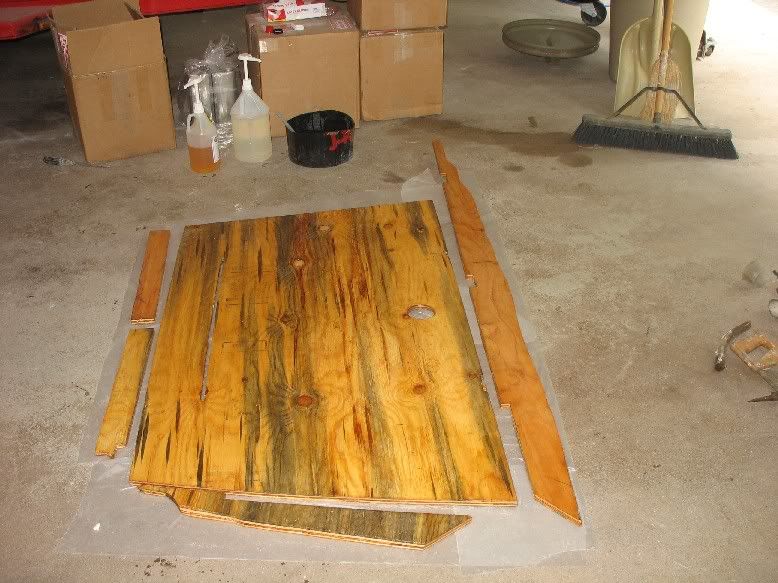

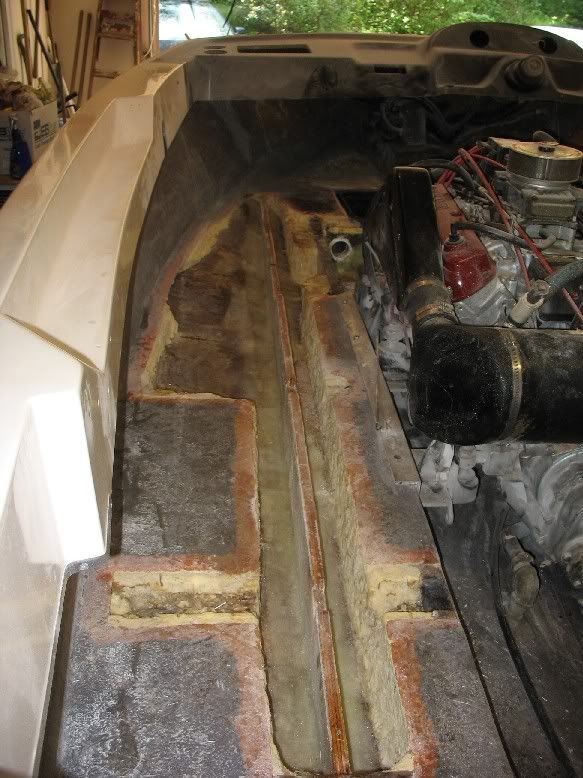
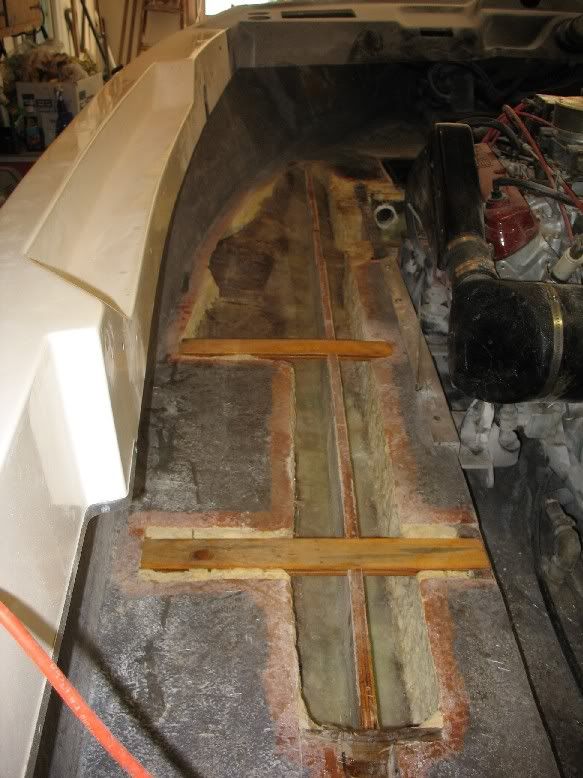
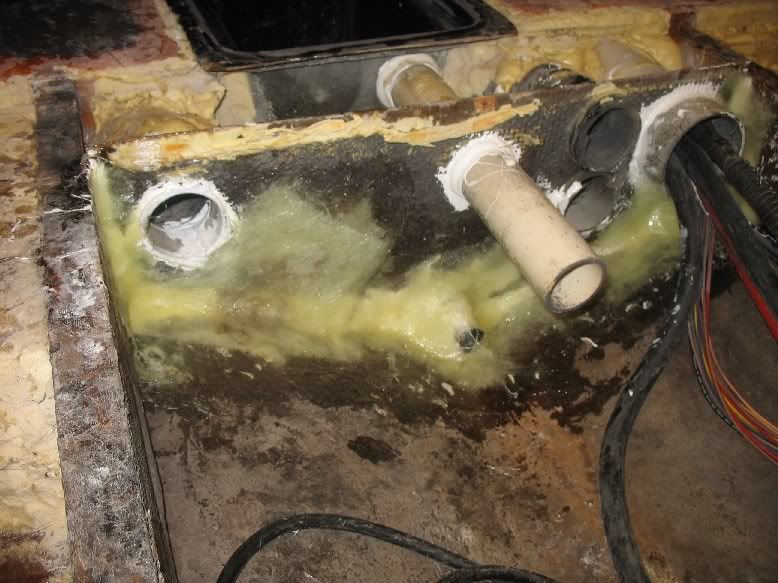
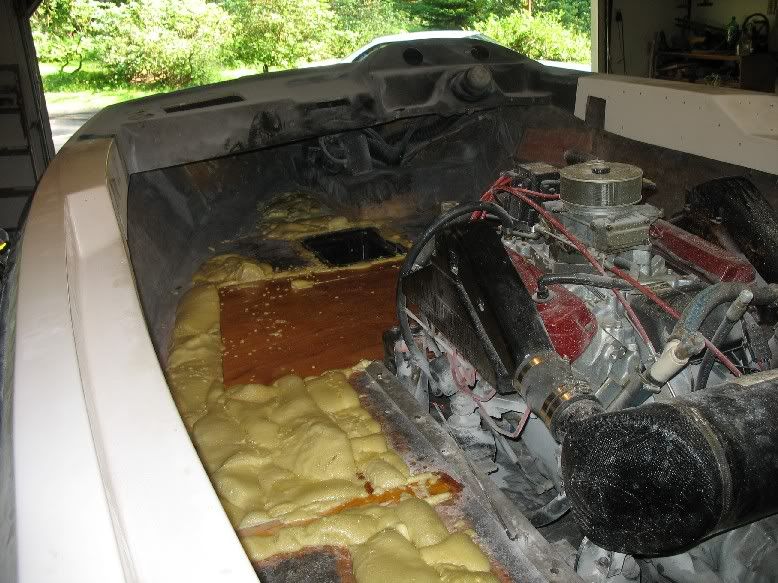


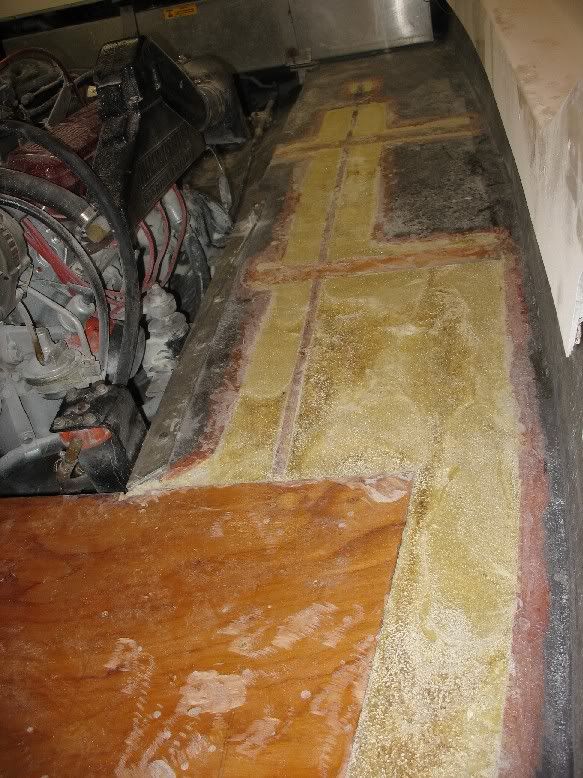
|
|
 |
|
TRBenj 
Grand Poobah 

Joined: June-29-2005 Location: NWCT Status: Offline Points: 21115 |
 Post Options Post Options
 Thanks(0) Thanks(0)
 Quote Quote  Reply Reply
 Posted: July-15-2006 at 10:44pm Posted: July-15-2006 at 10:44pm |
|
marks, thanks for pointing me in the right direction. I should have known to check their FAQ. Now I have a good plan for tomorrow!
|
|
 |
|
marks 
Groupie 
Joined: April-23-2004 Location: United States Status: Offline Points: 96 |
 Post Options Post Options
 Thanks(0) Thanks(0)
 Quote Quote  Reply Reply
 Posted: July-15-2006 at 10:33pm Posted: July-15-2006 at 10:33pm |
|
Tim,
US Composites has a FAQ that answers your question. Yes, you can do multiple layers but need to wait 15 to 20 minutes between them. http://www.shopmaninc.com/faq_foam.html#7 |
|
 |
|
Post Reply 
|
Page <123> |
|
Tweet
|
| Forum Jump | Forum Permissions  You cannot post new topics in this forum You cannot reply to topics in this forum You cannot delete your posts in this forum You cannot edit your posts in this forum You cannot create polls in this forum You cannot vote in polls in this forum |